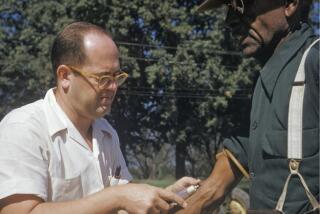Gap Grows Between Black Middle Class and Those Mired in Poverty, Study Finds : Income: Disparity threatens solidarity of African-Americans, report notes. Some scholars see economic status superseding racial identity.
- Share via
WASHINGTON — The gap between poor and affluent black Americans is widening, and the expanding black middle class increasingly is distancing itself from blacks locked in poverty and inner-city despair, a private research group reported Thursday.
Since the 1960s, the percentage of black Americans defined as affluent has more than doubled, according to a study by the Population Reference Bureau. But blacks at the bottom of the income ladder have made little progress, with roughly one-third still mired in poverty.
“You’ve got one segment moving up, and the other stuck at the bottom,” said William P. O’Hare, a social demographer at the University of Louisville and one of the authors of the black income study released by the Washington-based research bureau.
The report notes that, over the last two decades, widening economic fault lines among the nation’s 30 million blacks have undermined their sense of solidarity. Indeed, some black scholars and sociologists predict that racial identity will continue to recede in significance as class stratification assumes more relevance among black Americans.
“That would open a question about the nation’s black population and its efforts to improve its standing,” O’Hare said in an interview. “There seems to be two contrasting forces at work . . . the economic determination of some blacks, and the fact that racism is still present and holding many back.”
The report states that “the middle-class blacks of the future may feel little in common with poor blacks because their experiences will have been dramatically different in so many ways.”
The report shows that middle-class blacks have made significant advances in the last two decades. Nearly one in seven black families had an annual income of $50,000 or more in 1989, it said, compared with only one in 17 in 1967, after adjusting for inflation. The number of these affluent black families rose nearly fourfold, from 266,000 to more than 1 million.
Although income growth among black families has been “substantial,” the report notes, those gains still have not allowed them to catch up with their white counterparts. Nearly one in three white families earned $50,000 or more in 1989, it said, up from one in six in 1967.
The report cites a range of social and demographic indicators in which blacks still trail whites, including life expectancy, education and financial stability. “The gap between the well-being of blacks and whites is continuing evidence of the second-class status of African-Americans,” the report states.
But the report’s most striking finding is the growing economic divergence within black America itself as well as poverty’s stubborn hold on many black families.
While the population of affluent blacks has been expanding dramatically, 30.7% of all blacks remained stuck below the poverty line in 1989, the report shows. That represents only a marginal improvement from 32.2% in 1967.
“Our study shows the diversity of the African-American population,” said Kelvin Pollard, another Population Reference Bureau researcher who took part in the study.
“I think a lot of people think of the black population as a monolith, but it is not,” he said. “(Diversity) has not been studied to as great an extent among blacks as it has in the population at large, and I think it should be studied more.”
Pollard said that the current debate among blacks over Supreme Court nominee Clarence Thomas reflects the distinctive viewpoints of different segments of black society.
“There will be more and more reflections of the diversity among African-Americans as we enter the 21st Century, because the economic attitudes of African-Americans will produce more diversity,” he said.
Tanynia Mann, a research demographer at the bureau, said that the study’s findings suggest that class differences could lead to greater polarization among blacks.
The increasing economic stratification among blacks mirrors similar findings for the nation’s population as a whole.
According to a Census Bureau report to be released today, the share of the pretax income earned by the most affluent one-fifth of American households rose from 43% in 1969 to 46.8% in 1989. Meanwhile, the lowest fifth slipped from 4.1% in 1969 to 3.8% in 1989, and the middle three-fifths dropped from 52% in 1969 to 49.3% in 1989.
More to Read
Sign up for Essential California
The most important California stories and recommendations in your inbox every morning.
You may occasionally receive promotional content from the Los Angeles Times.













